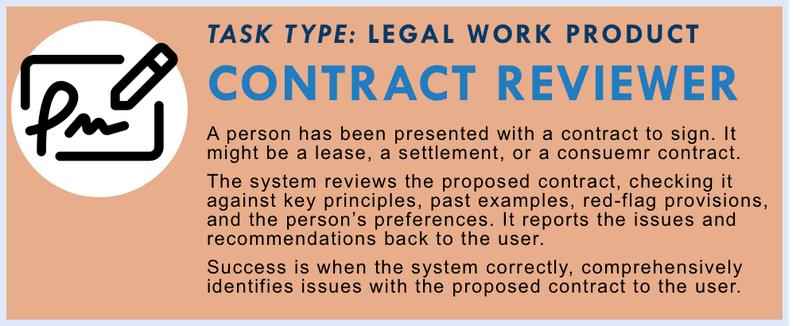Contract Reviewer

Help people evaluate a proposed contract or settlement agreement by checking it against their goals, legal standards, and practical consequences.
Task Description
When someone receives a proposed legal contract or settlement offer—from a landlord, creditor, government agency, or other party—they often must decide whether to accept it, negotiate further, or reject it and proceed with formal action. This decision is critical, but most people lack the legal knowledge, context, or confidence to evaluate a contract offer on their own.
This task focuses on a system that acts as a contract reviewer and guide. The user uploads or inputs the proposed agreement, and the system analyzes it in light of legal norms, common pitfalls, the user’s goals or needs, and examples from past contracts in similar cases. It then presents a structured report that flags concerns (e.g., unenforceable clauses, missing rights, unfair terms) and offers suggested edits or questions to raise.
The system doesn’t make the decision—it empowers the user with information. It shows trade-offs, compares the proposal to typical outcomes, and highlights whether key protections (like deadlines, payment terms, or appeal waivers) are clear and fair. If the user has shared their preferences or goals, the system checks alignment and notes potential mismatches.
This tool is especially useful for self-represented litigants facing pressure to sign agreements quickly, or for community navigators and legal help providers assisting users in negotiation contexts. It increases fairness and clarity while reducing the risk of people agreeing to harmful terms they don’t understand.
Success means that the system accurately and thoroughly analyzes a proposed contract, surfaces potential problems, and gives the person a clearer path to making an informed decision.
How to Measure Quality?
⚖️ Legal Soundness Review
- Identifies clauses that may be unenforceable, vague, or unlawful
- Flags waivers of rights, deadlines, or obligations that go beyond typical norms
- Compares proposal to relevant legal standards or guidance
🧩 User-Centered Alignment
- Analyzes how well the terms match the user’s expressed goals or constraints
- Highlights areas where the proposal departs from what the user hoped for or expected
- Suggests clarification questions for ambiguous terms
📋 Structural and Practical Completeness
- Flags missing elements (e.g., payment timeline, dispute resolution method)
- Checks whether each party’s obligations are clearly defined
- Notes if timelines, penalties, or follow-up steps are unreasonable or unclear
🧠 Comparative Benchmarking
- Compares proposal to past or typical contracts in similar issue areas
- Flags terms that are unusually harsh or favorable compared to common resolutions
- Supports optional review by legal experts or peer panels
🗣️ Clarity and Explanation
- Provides a plain-language summary of each term and its likely impact
- Visualizes pros/cons or trade-offs in a decision-making guide format
- Includes suggested edits or alternative language where appropriate
🧑💼 Review and Follow-Up Support
- Allows the user to export findings, notes, and redlines
- Generates questions the user could ask the other party or provider
- Offers routing guidance if expert legal review is recommended for final decision
Related Projects

Eviction Settlement Reviewer
A language-accessible AI assistant that reviews proposed eviction settlements to flag burdensome terms, explain how the settlement can play out, and support informed, strategic decision-making.

Lease Analyzer for Tenants
An AI-powered tool that helps tenants review residential leases before signing—spotting harmful or unenforceable clauses, translating legalese, and helping them make informed choices.